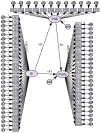Do perceived social support mitigate the influence of infertility stigma on fertility quality of life?
- PMID: 40810054
- PMCID: PMC12343516
- DOI: 10.3389/fgwh.2025.1577951
Do perceived social support mitigate the influence of infertility stigma on fertility quality of life?
Abstract
Introduction: Infertility is a medical condition that affects both males and females and can cause the individuals biopsychosocial, spiritual, and medical detriments. Quality of life among such couples or singles is a matter of concern. The question that we need to address is whether infertility affects the quality of life. Does the stigma associated with Infertility deter Infertile females from leading normal lives? This research explores how infertility stigma affects the quality of life of infertile females and whether perceived social support reduces the stress related to stigma thereby contributing to a better quality of life among females battling Infertility in India.
Methods: Participants from Jammu and Kashmir who identified as currently or previously infertile discussed their feelings about fertility stigma, the quality of their fertility-related social support, and their fertility quality of life. Only 302 fully complete questionnaires were obtained from the 351 identified individuals who were given data collection tools. Structural Equation Modeling (SEM) was used to treat data.
Results: It was seen that infertility stigma and perceived social support had an impact on fertility quality of life, either directly or indirectly. Infertility quality of life was reduced by stigma (β = -.413, SE = .017, p ≤ .01 level of significance, CI, 95%), and this link was partially mediated by infertile female's perceptions of social support (β = .512, p ≤ .01 level of significance, CI, 95%). In other words, it can be said that the negative effects of infertility stigma were buffered by perceived social support and improved fertility quality of life. Additionally, the sense of stigma was adversely linked with the overall quality of past fertility-related support.
Discussion: The findings of study confirms that perceived social support significantly mitigates the negative impact of infertility-related stigma on fertility quality of life among infertile females, highlighting the crucial role of emotional and social resources in mitigating distress. These findings emphasize the importance of encouraging supportive environment and interventions to enhance quality of life in females experiencing infertility stigma.
Keywords: female's health; fertility quality of life; infertility; infertility stigma; perceived social support.
© 2025 Al Sabbah, Tantry and Bayliss-Pratt.
Conflict of interest statement
The authors declare that the research was conducted in the absence of any commercial or financial relationships that could be construed as a potential conflict of interest.
Figures
Similar articles
-
Prescription of Controlled Substances: Benefits and Risks.2025 Jul 6. In: StatPearls [Internet]. Treasure Island (FL): StatPearls Publishing; 2025 Jan–. 2025 Jul 6. In: StatPearls [Internet]. Treasure Island (FL): StatPearls Publishing; 2025 Jan–. PMID: 30726003 Free Books & Documents.
-
Understanding Camouflaging, Stigma, and Mental Health for Autistic People in Japan.Autism Adulthood. 2025 Feb 5;7(1):52-65. doi: 10.1089/aut.2023.0035. eCollection 2025 Feb. Autism Adulthood. 2025. PMID: 40151661
-
Patient buy-in to social prescribing through link workers as part of person-centred care: a realist evaluation.Health Soc Care Deliv Res. 2024 Sep;13(27):1-17. doi: 10.3310/ETND8254. Health Soc Care Deliv Res. 2024. PMID: 39344953
-
Exercise interventions and patient beliefs for people with hip, knee or hip and knee osteoarthritis: a mixed methods review.Cochrane Database Syst Rev. 2018 Apr 17;4(4):CD010842. doi: 10.1002/14651858.CD010842.pub2. Cochrane Database Syst Rev. 2018. PMID: 29664187 Free PMC article.
-
Antioxidants for male subfertility.Cochrane Database Syst Rev. 2022 May 4;5(5):CD007411. doi: 10.1002/14651858.CD007411.pub5. Cochrane Database Syst Rev. 2022. PMID: 35506389 Free PMC article.
References
-
- Barrera N, Omolaoye TS, Du Plessis SS. A contemporary view on global fertility, infertility, and assisted reproductive techniques. In: Vaamonde D, Hackney AC, Garcia-Manso JM, editors. Fertility, Pregnancy, and Wellness. Amsterdam: Elsevier; (2022). p. 93–120. 10.1016/b978-0-12-818309-0.00009-5 - DOI
-
- Purkayastha N, Sharma H. Prevalence and potential determinants of primary infertility in India: evidence from Indian demographic health survey. Clin Epidemiol Glob Health. (2021) 9:162–70. 10.1016/j.cegh.2020.08.008 - DOI
LinkOut - more resources
Full Text Sources
Miscellaneous



